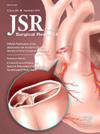伤口愈合的热信号
IF 1.8
3区 医学
Q2 SURGERY
引用次数: 0
摘要
背景:尽管在预防方面做出了巨大努力,但手术部位感染(SSI)仍然是患者和医疗系统的负担,并与严重的发病率相关。SSI 是医疗成本最高的相关感染之一。SSI 的诊断主要基于临床评估,这可能导致检测延迟。如果能在亚临床阶段检测到 SSI 并尽早启动有效治疗,则可降低发病率和缩短住院时间。在这项研究中,我们尝试利用长波红外成像(LWIR)来确定手术部位的愈合过程并检测异常愈合:在这项前瞻性研究中,50 名接受择期腹部手术的患者从手术到出院期间,每隔一段时间就会采集切口的长波红外图像。采用专有算法对图像进行处理,以创建用于确定愈合过程的热地形图:共有 45 名患者的图像可供最终审核。在这 45 名患者中,有 10 名患者出现了 SSI。通过热地形图,确定了 10 项图像分析标准,预测出 10 例 SSI 中的 6 例和 35 例正常愈合伤口中的 35 例。灵敏度为 60%,特异性为 100%,阳性预测值为 100%,阴性预测值为 90.1%,准确率为 92%。我们还创建了一个初步的程序,让经过培训的用户有条不紊地评估图像,为他们提供风险估计:在这项初步研究中,手术伤口的长波红外分析能够识别正常和异常的伤口愈合。需要进一步的大规模研究来验证结果。本文章由计算机程序翻译,如有差异,请以英文原文为准。
The Thermal Signature of Wound Healing
Background
Despite major efforts in prevention, surgical site infections (SSIs) remain a burden on patients and the healthcare system and are associated with significant morbidity. SSIs are one of the costliest healthcare-associated infections. The diagnosis of SSIs is based mainly on clinical assessment, which may result in a delay in detection. The ability to detect SSIs in subclinical phase and initiate effective therapy earlier may reduce morbidity and hospital stay. In this study, we attempted to utilize long-wave infrared (LWIR) imaging to define the healing process of the surgical site and to detect abnormal healing.
Methods
In this prospective study, 50 patients undergoing elective abdominal surgery had LWIR images of their incision obtained at determined intervals from their operation to discharge. Images were processed with proprietary algorithms to create a thermal topograph used to define the healing process.
Results
Images of 45 patients were available for a final review. Of these 45 patients, 10 patients developed SSIs. Using the thermal topograph, 10 criteria for image analysis were defined, yielding a prediction of six out of the 10 SSIs and 35 out of the 35 normal healing wounds. Sensitivity was 60%, specificity was 100%, positive predictive value was 100%, and negative predictive value was 90.1%, with 92% accuracy. A preliminary program was created that allows trained users to methodically evaluate images providing them with a risk estimate.
Conclusions
In this preliminary study, LWIR analysis of surgical wounds was able to identify normal and abnormal wound healing. Further large-scale studies are needed to validate results.
求助全文
通过发布文献求助,成功后即可免费获取论文全文。
去求助
来源期刊
CiteScore
3.90
自引率
4.50%
发文量
627
审稿时长
138 days
期刊介绍:
The Journal of Surgical Research: Clinical and Laboratory Investigation publishes original articles concerned with clinical and laboratory investigations relevant to surgical practice and teaching. The journal emphasizes reports of clinical investigations or fundamental research bearing directly on surgical management that will be of general interest to a broad range of surgeons and surgical researchers. The articles presented need not have been the products of surgeons or of surgical laboratories.
The Journal of Surgical Research also features review articles and special articles relating to educational, research, or social issues of interest to the academic surgical community.

 求助内容:
求助内容: 应助结果提醒方式:
应助结果提醒方式:


